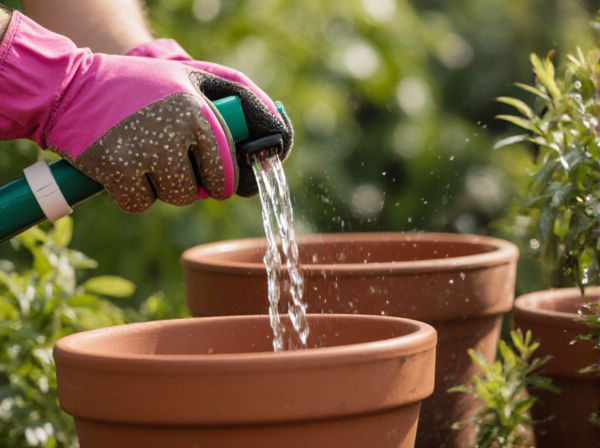
Pot watering vs In-ground watering Illustration
Pot watering requires more frequent checks as containers dry out faster and limit root growth compared to in-ground watering, which benefits from deeper soil moisture retention. In-ground watering supports natural root expansion and reduces water evaporation, making it more efficient for garden plants. However, pot watering offers greater control over water amounts and soil conditions, ideal for delicate or potted plants.
Table of Comparison
| Feature | Pot Watering | In-Ground Watering |
|---|---|---|
| Water Efficiency | Moderate; water drains quickly | High; water seeps deep into soil |
| Root Growth | Limited by pot size | Unrestricted; natural expansion |
| Moisture Retention | Low; pots dry faster | High; soil retains moisture longer |
| Plant Health | Requires frequent monitoring | Stable environment; less stress |
| Flexibility | Highly portable | Fixed location |
| Setup Cost | Low to moderate | Moderate to high (irrigation systems) |
| Maintenance | Frequent watering needed | Less frequent; automated options |
Introduction to Pot Watering vs. In-Ground Watering
Pot watering requires frequent attention due to limited soil volume, which restricts moisture retention and root growth compared to in-ground watering. In-ground watering benefits from natural soil layers that retain moisture longer and support extensive root systems, promoting healthier plant development. Understanding these differences helps optimize watering schedules and improve plant health.
Understanding the Watering Needs of Potted Plants
Potted plants require more frequent watering than in-ground plants due to limited soil volume, which dries out faster and holds fewer nutrients. Understanding the specific water retention capacity of potting mix and the plant species' moisture needs is essential for effective pot watering. Using well-draining pots and monitoring soil moisture regularly helps prevent root rot and ensures optimal plant health.
Soil Differences: Pots vs. Garden Beds
Soil in pots typically retains moisture differently than garden beds due to limited volume and drainage constraints, often requiring more frequent watering. Garden bed soil benefits from natural earth composition and microbial activity, promoting better water absorption and retention. Understanding these soil differences is crucial to avoid overwatering pots or under-watering in-ground plants, ensuring optimal hydration and plant health.
Water Retention and Drainage in Pots
Pot watering requires careful attention to water retention and drainage, as pots often have limited soil volume that can dry out quickly without proper moisture control. Using pots with adequate drainage holes and well-draining soil mixtures prevents waterlogging, which can lead to root rot and poor plant health. Conversely, in-ground watering benefits from natural soil structure that typically retains moisture longer and allows excess water to percolate effectively, reducing the risk of overwatering.
Moisture Distribution in In-Ground Gardens
In-ground watering provides superior moisture distribution by delivering water directly to plant root zones, promoting deeper soil penetration and reducing surface evaporation. This method enhances soil aeration and encourages robust root systems compared to pot watering, where moisture often remains concentrated in the limited container space. Effective in-ground irrigation systems, such as drip lines or soaker hoses, optimize water efficiency and support healthier, more resilient plants.
Frequency and Amount: How Often to Water Pots vs. In-Ground Plants
Pot plants typically require more frequent watering due to limited soil volume, often needing water every 1-3 days depending on temperature and plant type, whereas in-ground plants benefit from deeper, less frequent watering, generally once or twice a week. The amount of water for pots must saturate the root ball without causing waterlogging, while in-ground watering targets deeper soil layers to encourage root growth and drought resilience. Monitoring soil moisture levels is critical for both methods to prevent overwatering or underwatering and maintain optimal plant health.
Choosing the Right Watering Tools for Each Method
Selecting appropriate watering tools depends on whether you're watering pots or in-ground plants. For pots, a watering can with a narrow spout or self-watering systems ensures precise water delivery to avoid overwatering. In-ground plants benefit from drip irrigation or soaker hoses that provide deep, consistent moisture while conserving water and reducing runoff.
Challenges and Advantages of Pot Watering
Pot watering offers precise control over soil moisture levels, reducing water waste and promoting healthier plant growth by targeting root zones directly. However, challenges include faster soil drying due to limited soil volume and the risk of overwatering, which can lead to root rot. Unlike in-ground watering, pots require more frequent monitoring and tailored watering schedules to maintain optimal hydration.
Benefits and Drawbacks of In-Ground Watering
In-ground watering provides consistent moisture to deep root zones, promoting stronger and more resilient plant growth while reducing surface evaporation. However, it requires initial installation costs and can be less flexible for adjusting water delivery to individual plants compared to pot watering. This method is highly efficient for established landscaping, but may cause root over-saturation or waterlogging if not properly managed.
Tips for Efficient Watering in Every Gardening Setup
Pot watering requires frequent, deep watering using well-draining soil and self-watering pots to conserve moisture effectively. In-ground watering benefits from targeted drip irrigation or soaker hoses to deliver water directly to plant roots while minimizing evaporation. Adjust watering schedules based on soil moisture levels and seasonal changes to ensure optimal hydration in any gardening setup.
Pot watering vs In-ground watering Infographic

 gardendif.com
gardendif.com